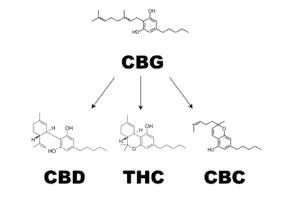
A common theme in hemp research is the pace of discovery, specifically how fast it is! We are continually learning about new and exciting potential uses for hemp and the various compounds within. One of the hotter topics right now is CBG. What is CBG? Let’s discuss.
CBG Explained
CBG – short for cannabigerol – is another phytocannabinoid found in the hemp plant. Just like CBD and THC, CBG is another kind of cannabinoid with its own specific characteristics.
Actually, CBG is known as the ‘mother cannabinoid’. This is because the acid form of CBG – CBGA – is what every cannabinoid starts as. From there, it is transformed into different secondary and tertiary cannabinoids. These include CBD, THC, CBC, and more.
CBG vs. CBD: What’s the difference?
Like CBD, CBG is non-intoxicating, meaning it doesn’t get you ‘high’. CBG also interacts with our endocannabinoid system in ways very similar to CBD. CBG may also support a healthy inflammatory response from our endocannabinoid system, as CBD does.
There is not a lot of research done on CBG at this time. Nevertheless, there are some preliminary studies that show potential benefits and warrant further research.
How might CBG be beneficial?
The limited research that is available on CBG highlights some interesting and exciting preliminary findings:
- May inhibit tumor growth, including breast and prostate cancer (Baek et al., 1998; Ligresti et al., 2006; De Petrocellis & Di Marzo, 2010; Mukerji et al., 2006)
- Neurological effects shown in rodent model studies, including antidepressant and neuroprotective (Maor, Gallily, & Mechoulam, 2006; Mystery & Deyo, 2006; Formukong, Evans, & Evans,, 1998)
- Topical skin applications, including antibacterial, antifungal, anti-psoriasis, and pain-relieving (Appendino et al., 2008; De Petrocellis et al., 2011; Wilkinson & Williamson, 2007; ElCohly, Turner, Clark, & Eissoholy, 1982; Evans, 1991; Cascio et al., 2010)
Given all of these exciting potential uses, CBG will certainly be the focus of further research. In the past year alone, the US National Library of Medicine has 116 new research articles on CBG!
Is there CBG in Danodan products?
The hemp that Danodan uses is grown and bred primarily for its higher level of CBD. That being said, YES, there is also CBG present in Danodan products!
In our higher-potency products (with a yellow or red label), the level of CBG varies from about 0.25-0.5mg per mL. Even at lower levels, your body will surely use CBG as it is metabolized.
Look at our Lab Results page and view the Lightscale Lab for any of our products. The first page of that report is where you will find information about the various cannabinoids in that particular batch. For more information on how to read our lab results, click here.
This is a great reason why we love making a full-spectrum product. Because Danodan contains all of the natural compounds found in hemp, you’re getting more than just CBD – much more!
In Conclusion
So what is CBD? Cannabigerol – CBG – is a phytocannabinoid found in the hemp plant, at varying levels. It acts similar to CBD, but with some different applications.
Research on CBG is scarce but growing. Preliminary evidence suggests exciting potential for CBG, but further research is needed.
Full-spectrum hemp products like Danodan Hemp Flower Infusions contain small amounts of CBG and other cannabinoids. The full array of beneficial plant compounds in our products means greater therapeutic effects for specific symptoms or everyday well-being!
References:
CBD Certified presentation. Anna Symonds / East Fork Cultivars. 14 Aug 2020. Online.
https://www.healthline.com/health/cbg-oil
This statement has not been evaluated by the FDA. This product is not intended to diagnose, treat, cure, or prevent any disease.
